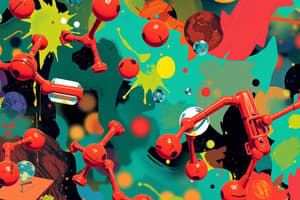Podcast
Questions and Answers
What is the role of the dopamine transporter?
What is the role of the dopamine transporter?
The dopamine transporter is responsible for reuptake of dopamine into nerve terminals for reuse or into glial cells.
How is the dopamine transporter inhibited?
How is the dopamine transporter inhibited?
The dopamine transporter is inhibited by cocaine and amphetamines.
What are the two mechanisms of enzymatic degradation of dopamine?
What are the two mechanisms of enzymatic degradation of dopamine?
The two mechanisms of enzymatic degradation of dopamine are monoamine oxidase (MAO) and catechol-O-methyltransferase (COMT).
Where are MAO enzymes located and what is their function?
Where are MAO enzymes located and what is their function?
What is the function of COMT?
What is the function of COMT?
What are the key degradation enzymes for dopamine?
What are the key degradation enzymes for dopamine?
What are the diseases associated with the dopamine system?
What are the diseases associated with the dopamine system?
What is the main pathology in Parkinson's disease?
What is the main pathology in Parkinson's disease?
What are the neural projections involved in motor control?
What are the neural projections involved in motor control?
What are the sites of action of common treatments for Parkinson's disease?
What are the sites of action of common treatments for Parkinson's disease?
What are biogenic amines?
What are biogenic amines?
What is the common structural feature of catecholamines?
What is the common structural feature of catecholamines?
Which neurotransmitter is a catecholamine?
Which neurotransmitter is a catecholamine?
What is the biosynthetic pathway for catecholamines?
What is the biosynthetic pathway for catecholamines?
What is the role of tyrosine hydroxylase?
What is the role of tyrosine hydroxylase?
What is the function of norepinephrine and epinephrine?
What is the function of norepinephrine and epinephrine?
What is the name of the transporter that mediates uptake into and storage in vesicles?
What is the name of the transporter that mediates uptake into and storage in vesicles?
What is the role of dopamine β-hydroxylase (DBH) in vesicles?
What is the role of dopamine β-hydroxylase (DBH) in vesicles?
What are the main types of dopamine receptors?
What are the main types of dopamine receptors?
What is the function of D1-like receptors and D2-like receptors?
What is the function of D1-like receptors and D2-like receptors?
Study Notes
Dopamine Transporter and Degradation
- The dopamine transporter is responsible for the reuptake of dopamine from the synapse, terminating the signal.
- Inhibition of the dopamine transporter can be achieved through cocaine and other psychostimulants.
- Dopamine degradation occurs through two mechanisms: enzymatic degradation and reuptake.
- Enzymatic degradation involves the breakdown of dopamine by two enzymes: monoamine oxidase (MAO) and catechol-O-methyltransferase (COMT).
Monoamine Oxidase (MAO)
- MAO enzymes are located in the outer mitochondrial membrane and are responsible for the breakdown of dopamine.
- MAO has two forms: MAO-A and MAO-B, with different substrate specificities.
Catechol-O-Methyltransferase (COMT)
- COMT is responsible for the transfer of a methyl group to dopamine, inactivating it.
- COMT is found in the synaptic cleft and is involved in the degradation of dopamine.
Diseases Associated with Dopamine System
- Diseases associated with the dopamine system include Parkinson's disease, schizophrenia, and attention deficit hyperactivity disorder (ADHD).
Parkinson's Disease
- The main pathology in Parkinson's disease is the degeneration of dopamine-producing neurons in the substantia nigra, leading to motor symptoms.
- The neural projections involved in motor control are the cortico-striatal-thalamo-cortical circuit and the basal ganglia.
Treatments for Parkinson's Disease
- The sites of action of common treatments for Parkinson's disease include the dopamine transporter, dopamine receptors, and monoamine oxidase (MAO) inhibitors.
Biogenic Amines and Catecholamines
- Biogenic amines are a class of neurotransmitters that include dopamine, norepinephrine, and serotonin.
- Catecholamines are a subclass of biogenic amines that include dopamine, norepinephrine, and epinephrine, characterized by a catechol group.
- Dopamine is a catecholamine neurotransmitter.
Biosynthetic Pathway for Catecholamines
- The biosynthetic pathway for catecholamines involves the conversion of tyrosine to L-dopa by tyrosine hydroxylase.
- L-dopa is then converted to dopamine by aromatic L-amino acid decarboxylase.
Tyrosine Hydroxylase
- Tyrosine hydroxylase is the rate-limiting enzyme in the biosynthetic pathway of catecholamines.
Norepinephrine and Epinephrine
- Norepinephrine and epinephrine are catecholamine neurotransmitters involved in the sympathetic nervous system.
Vesicular Transport and Storage
- The vesicular monoamine transporter (VMAT) mediates the uptake of dopamine into vesicles for storage.
Dopamine β-Hydroxylase (DBH)
- Dopamine β-hydroxylase (DBH) is an enzyme involved in the conversion of dopamine to norepinephrine in vesicles.
Dopamine Receptors
- The main types of dopamine receptors are D1-like receptors and D2-like receptors.
- D1-like receptors are involved in the activation of adenylyl cyclase, increasing cAMP levels.
- D2-like receptors are involved in the inhibition of adenylyl cyclase, decreasing cAMP levels.
Studying That Suits You
Use AI to generate personalized quizzes and flashcards to suit your learning preferences.
Related Documents
Description
Test your knowledge on biogenic amines, bioactive amine neurotransmitters implicated in various behaviors such as movement, reward, addiction, depression, and sleep. Learn about the catecholamines and their role as neurotransmitters like dopamine and norepinephrine. Explore the pharmacological drugs that affect their neurotransmission.




